- The Moneycessity Newsletter
- Posts
- Why is Everybody Buying CARVANA?
Why is Everybody Buying CARVANA?
Carvana has been one of the most volatile stocks on the market. Fortunes have been won, lost, and won again. Now that Carvana is rising from its latest crash, is it a good time to buy?
Carvana is on track to hit a new revenue all-time-high and yet its stock price is less than half of what it was three years ago.
There is a noticeable disconnect between revenue and share price. Just a year and a half ago, Carvana was down 99% from all-time highs while annual revenue was only down about 25%.
If you bought CVNA when it was $4 per share and rode it back to $160 then you have made a lot of money. But the next question is will CVAN get back to $340?
To answer this question, I spent the last 3 weeks reading over 500 pages of Carvana’s financial reports since 2017 and put all the data in pretty graphs so we can easily see the trends. Let’s go.
On the go? Watch my video HERE.

Finally, a Good Time to Buy CARVANA?
Carvana’s Statement of Cash Flow
The first step is to analyze the statement of cash flows.
A company will divide its cash flows into three major categories — cash flow from operations, investing, and financing.
A growing company typically has negative net cash flow from operations and investing. This was the case for Carvana from 2017 to 2022.
Operations will produce positive cash flow once a growing company fully benefits from the economy of scale. Investing cash flow will remain negative as more cash is spent on growth. In Carvana’s case, expanding into new markets requires large investments.
The fuel that a growing company burns is cash from financing. Carvana has been taking on debt and issuing shares of stock to fund both operations and investing cash flows.

Carvana Statement of Cash Flows by Year — Illustration by author
In 2023, we see a flip. One full year of positive cash flow from operations and progress paying off long-term debt (negative financing cash flow). However, the cash flow from investing flipped to the positive as well, which indicates Carvana is not currently focusing on growth.
We can also begin to understand why Carvana’s share price took such a nosedive at the end of 2021 and the beginning of 2022. Carvana took on a lot of debt between those two years to make up for the poor cash flow from operations in 2021 and huge investments in 2022.

Carvana Acquires ADESA U.S.
In May of 2022, Carvana acquired ADESA — a vehicle auction business that has 56 locations in the United States. Carvana will synergize nicely with the physical auction company as it will have access to additional markets and lower transportation costs.
However, Carvana had to fund this future growth somehow — and it certainly wasn’t from cash from operations.
Carvana was forced to take on nearly $3.5 billion in long-term debt and issued $1.23 billion worth of shares. Both diluting current shareholders and increasing debt contributed to the drop in share price at the time.

Carvana Statement of Cash Flows by Year
Carvana’s Profit by Year
The next chart we must analyze is Carvana’s profit by year going back to 2017. The massive losses in 2022 were a major red flag to investors at that time. Losing $1.587 billion in a single year nearly doubled all previous losses combined.
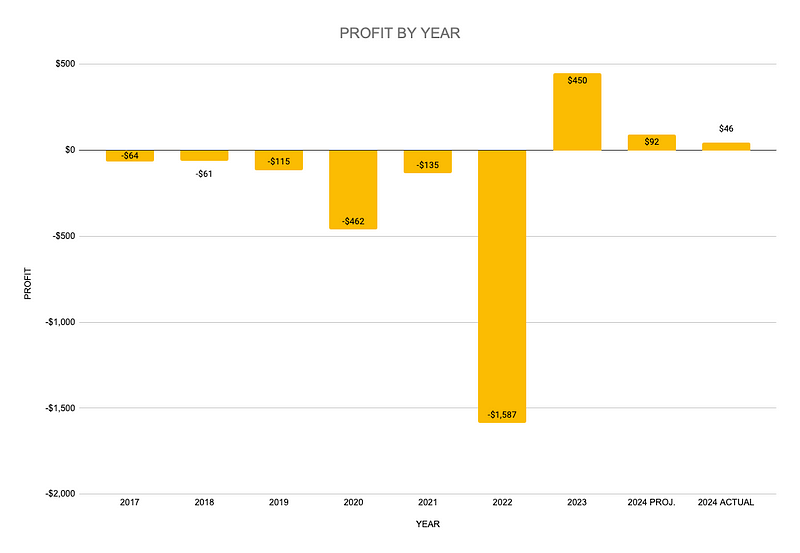
Carvana Profit by Year — Illustration by author
Carvana’s earnings not only align with the stock price crash but also the rebound. Going from losing $1.587 billion to profiting $450 million is an impressive turnaround!
Carvana is also on track to have a second profitable year in a row as they profited $46 million after the first two quarters.

Carvana Share Price
Everything seems to be going well… on the surface. Now we must look a little deeper into the breakdown of profit and cash flow.
The Problem with Profit by Year
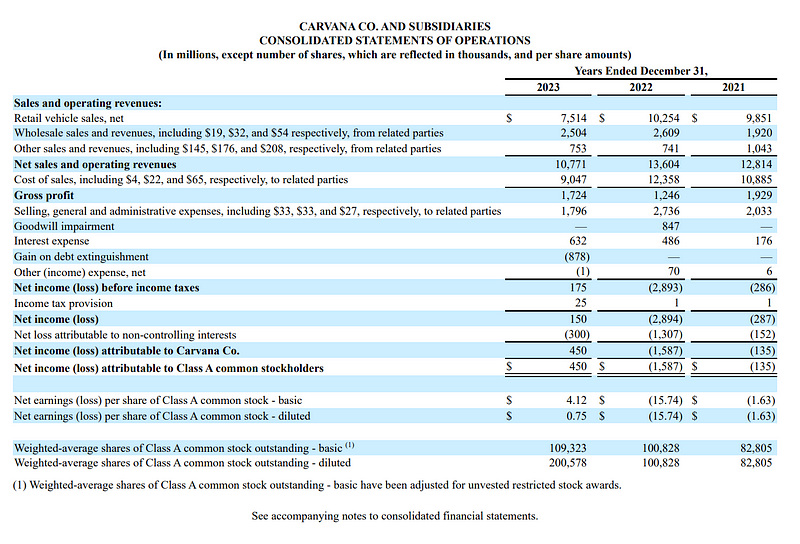
Carvana 2023 Annual Report — Statement of Operations
First, the losses in 2022 are not as bad as they appear.
Carvana claimed a Goodwill impairment loss of $847 million, which is a noncash loss. Goodwill impairment occurs when a company pays more than book value for the acquisition of an asset. Carvana paid $838 million more than what ADESA is worth.
The chart below shows the breakdown of ADESA’s assets and liabilities.

Carvana 2023 Annual Report — Goodwill Impairment
The second number that jumps out at me is the $878 million gain on debt extinguishment. Carvana had a chunk of debt that was due for payment that they weren’t able to afford. Since there was a real risk of bankruptcy, Carvana’s creditors renegotiated their debt with Carvana.
Carvana was able to reduce the total amount (by $878 million) and push the due date back. In return, Carvana would secure the debt with its assets and pay a higher interest rate.
In reality, Carvana did not profit $450 million from improving its operations, it had a one-time debt restructuring. Otherwise, Carvana would have lost $428 million that year instead of gaining $450 million on paper.
In the first two quarters of 2024, Carvana is claiming a profit of $46 million.
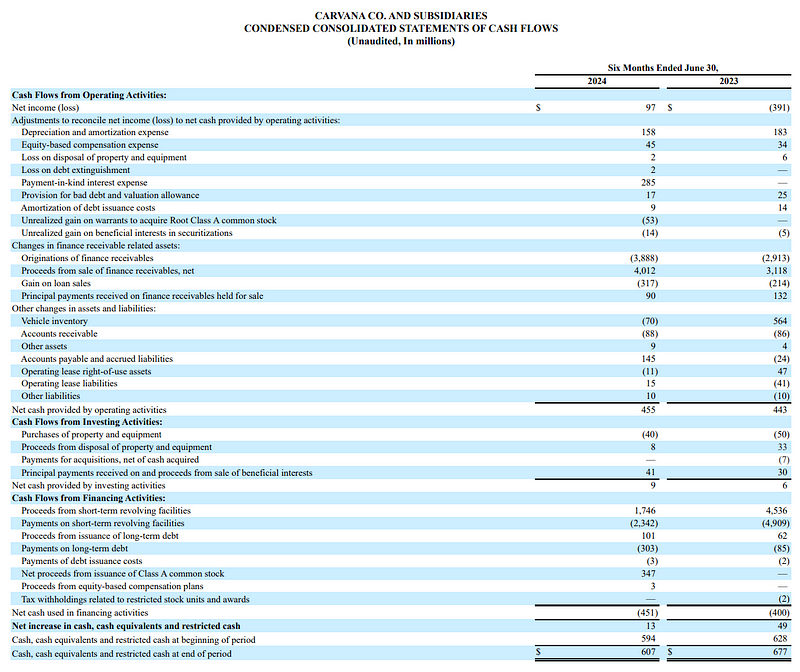
Carvana 2024 2nd Quarterly Report
However, the breakdown shows a one-time gain of $53 million, which is titled “unrealized gain on warrants to acquire Root class a common stock”. Carvana received these options from Root, the insurance company with which Carvana partners.
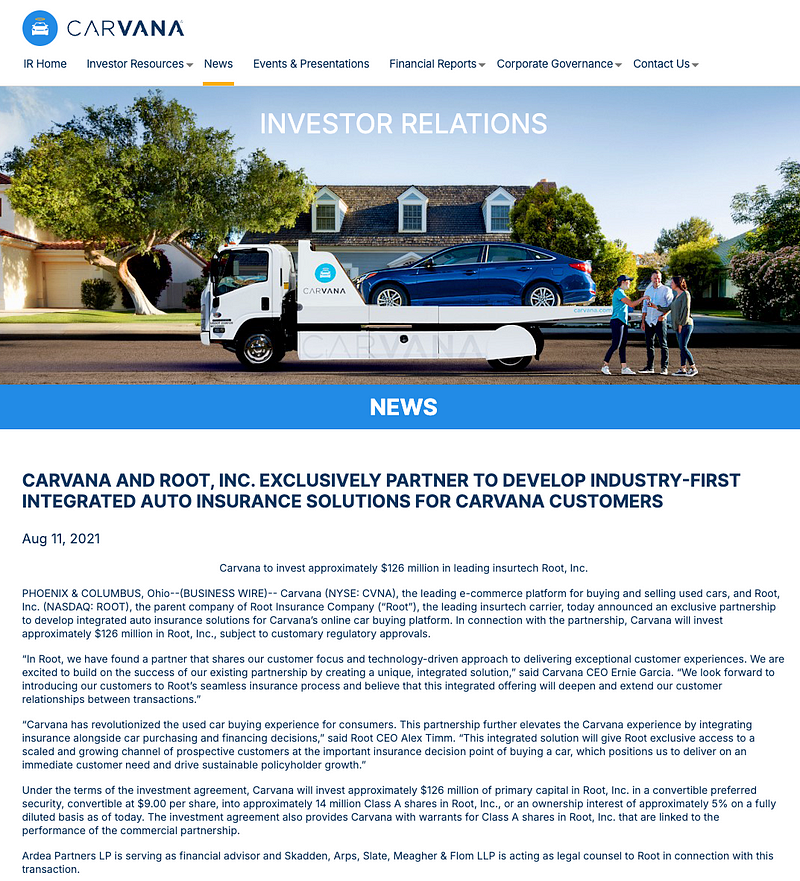
Carvana Insurance Partner — ROOT
Unrealized gains are just barely pushing Carvana up into profitability. Perhaps this is a bit nitpicky, but $53 million does wipe out Carvana’s profit for the year so far in 2024.
After adjusting profit to exclude the one-time benefits, Carvana’s performance looks less like an amazing turn-around story.

Carvana Adjusted Profit by Year — Illustration by author
The Problem with Cash Flow From Investing
Over the long term, earnings are an accurate measure of a company's success. However, in the short term, analyzing Carvana’s statement of cash flows gives much more insight into their direction.

Carvana Statement of Cash Flows by Year — Illustration by author
Carvana’s cash spent on investing dropped off a cliff from 2022 to 2023. They are not investing in growth at all.
Carvana is doing everything it can to be profitable. They’ve already kicked the can down the road once with a major debt restructuring, they may not be able to do it again.
Carvana must generate enough cash flow from operations not only to pay off its growing interest payments but also to pay off debt when due.
The Problem with Cash Flow from Operations
In 2023, Carvana is claiming $803 million positive cash flow from operations. Are there any details buried in the statement of cash flows that can shed more light on the situation?
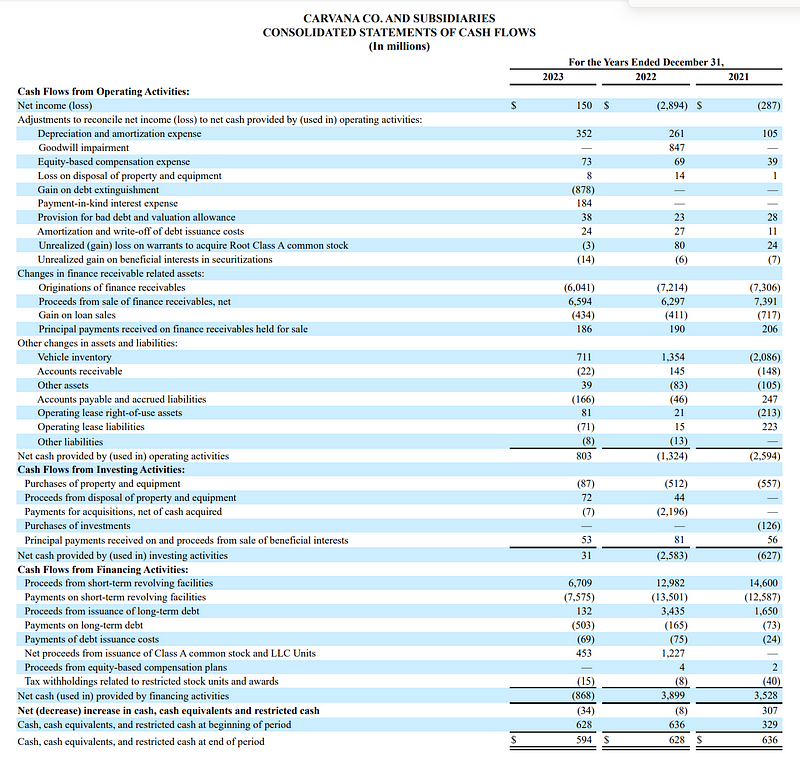
Carvana 2023 Annual Report — Statement of Cash Flows
Carvana is showing a positive cash flow of $711 million due to changes in vehicle inventories. Carvana either had surplus inventories or they were not replacing inventories as they made sales. The result of a shrinking inventory is increased cash flow, but it is not sustainable.
In 2022 and 2021, it seems likely that Carvana was able to cash in on surplus inventories that were built up in the previous two years.
By taking the average cash flow from inventories (-$7) over the three years shown, we can smooth out the lumpy results. Using -$7 instead of $711 as the adjusted cash flow from inventories would wipe out most of Carvana’s positive cash flow from operations.

Carvana 2023 Annual Report — Statement of Cash Flows
A second line item that jumps out at me is the payment in kind interest. This is an expense that they are not paying, which means it is adding to their cash flow. Payment in kind (PIK) in this context means in exchange for delaying interest payments today, Carvana will pay a higher interest payment later.
To determine if Carvana can afford its interest payments, I would not give credit to cash flow from PIK. I prefer to adjust cash flow so that PIK and temporary inventory swings do not affect the results.
The following graph shows the adjusted cash flow from operations.

Carvana 2023 Adjusted Annual Cash Flow of Operations — Illustration by author
The net cash flow is reduced by the total change in assets and liabilities and reduced by PIK. Carvana has an adjusted cash flow from operations of $55 million in 2023. That is not a lot of extra cash to pay off debt.
In 2024, for the first two quarters only, Carvana is showing $455 million in positive cash flow from operations. So far in 2024, their assets and liabilities are pretty well balanced so adjustments will be minor.

Carvana 2024 Q2 Quarterly Report — Statement of Cash Flows
However, payment in kind (PIK) has grown substantially. $285 million PIK for just two quarters means Carvana is on pace to exceed $570 million PIK for the year — more than 3X the previous year's PIK.
After subtracting the changes in assets/liabilities and PIK, Carvana’s adjusted cash flow from operations (so far) in 2024 is $160 million.
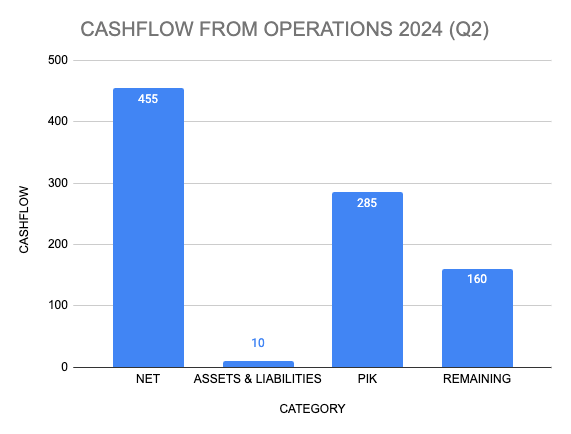
Carvana 2024 Q2 Adjusted Cash Flow From Operations — Illustration by author
The Problem With Cash Flow From Financing
Finally, I have compiled Carvana’s interest payments by year in the following graph. From 2021 to 2022, Carvana’s interest payment more than doubled, which also coincides with the beginning of their first crash.

Carvana Interest Payments by Year — Illustration by author
The interest expense in 2024 for the first two quarters is $346 million which means they are on pace to have the largest annual interest expense to date. PIK will continue to increase Carvana’s interest payments.
Carvna must increase its profitability to not only keep up with its interest payments but also pay off its long-term debt when due. The temporary relief given by PIK will go away at the end of 2024.
Unfortunately, there is another black mark on their financial statement.
In 2021, Carvana had just under 90 billion shares of stock. Today, in 2024, after two quarters, Carvana is up to 121 billion shares of stock — on track to have 128 billion shares outstanding by the end of 2024.

Carvana Class A Common Stock Issued by Year — Illustration by author
Since all-time highs, the stock has been diluted by 26%. If Carvana issues the same number of shares in the second half of 2024, the stock will be diluted by 30%.
If Carvana is ever to reach its previous all-time high of $360, the dilution will make it that much more difficult. A share price of $360 today is equivalent to a $468 share price in 2021.

Carvana Share Price
Carvana has made some progress on its long-term debt. The following chart shows Carvana’s net change in long-term debt by year.

Carvana Long-Term Debt Progress — Illustration by author
The effort to increase profitability is paying off.
The long-term debt direction drastically swung — from $3,270 million to $371 million. Unfortunately, the positive progress towards long-term debt is thanks to the money raised from issuing shares of stock.
The chart below shows the net proceeds from dilution.

Carvana Proceeds from Issuing Stock by Year — Illustration by author
Carvana is scraping by as interest payments reach all-time highs, the PIK option is near expiration, and new shares are issued every year.
So What Now?
After digging a little deeper into Carvana’s financial statements, I am skeptical that they will be reaching $360 per share anytime soon. In fact, I’m now suspicious of their current share price.
There is a lot of hype around this company and there are a lot of people buying Carvana with the promise of exponential growth. But now that I know it’s not a good time to buy Carvana, what is a fair share price?
I’m thinking of making part II if we get 500 claps. In the meantime, click HERE for my automated system to calculate the intrinsic value of a company stock.
Catch you on the flip side.

Reply